Part 20: FredMSloniker - The Farm Game
Chokes McGee posted:
I think after Beekeeper and the custom stuff we'll shut 'er down. Last call to anyone who wants to contribute! I.E. where the fuck is Crossroads 2
If interest picks up after some more games are posted then we'll keep going, though!
Awww! I've got lots more material. Including this!
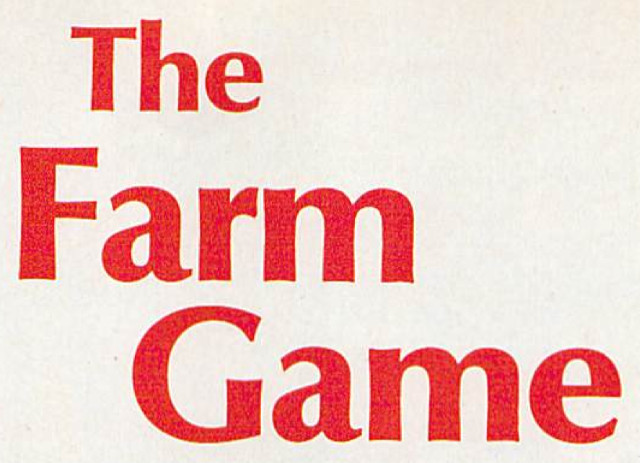
Let's Play The Farm Game
Compute!'s Gazette, October 1985, Issue 28, Volume 3, Number 10
Before I get into talking about the game, can I just take a moment to mention this?

This wasn't uncommon in the earlier issues of the Gazette, though fewer and fewer people did it over time. Right now, I could get a cassette tape for about $3. Envelopes are about $5 for a box of 50, so ten cents each, need two. A postage stamp cost 22 cents in late 1985, and I'll need two of those. Add that to the $3 in 1985 money I'll need, and that's about $7.58 in modern money. Add in the $3.20 for cassette tape and envelopes, and I'm looking at $10.78.
Now, I don't know what time machine rental costs these days, but I think I would have paid someone $11 to type this in for me.
Anyway. The Farm Game is a game in a genre that existed before microcomputers did. To my knowledge, the first one to have survived history is Hamurabi (sic), which was written in 1968 as The Sumer Game and expanded on in the 1973 book BASIC Computer Games (archived online), where it got the name it has today. (Note: I was born in 1973. This book is as old as I am.)
Both The Sumer Game and Hamurabi would originally have been played on a teleprinter (Teletype was the most common brand name for them), which was essentially a typewriter hooked up to a remote computer. You'd type in your choices, the time-shared minicomputer or mainframe you were connected to would process them, and it'd send back your results as text that the teleprinter would print. Teleprinters are still in use today, to my surprise, in the aviation industry. Linux users may also be aware of its legacy in the form of /dev/tty.
The Farm Game is, of course, more sophisticated than Hamurabi, but strangely lacks at least one of its features. More on that later.
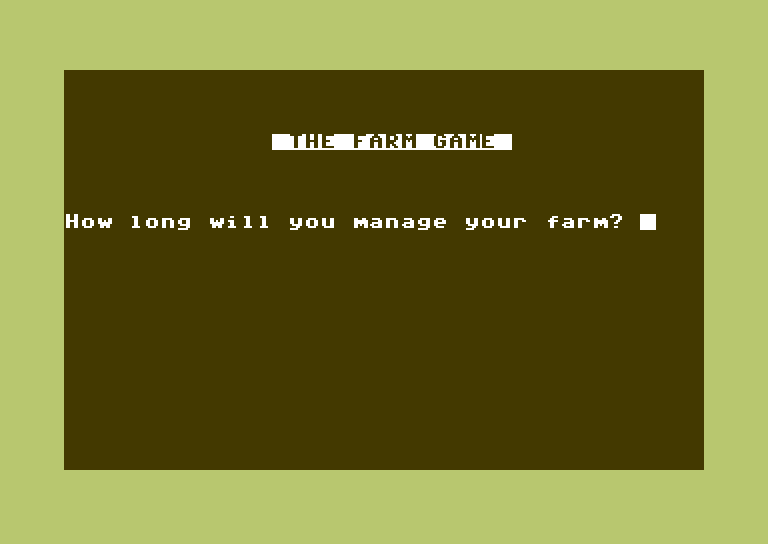
At the beginning of the game, you choose how many years you want to spend playing. There's no upper limit, or at least none you'll hit. (Though if you put in a number over a billion, floating point math imprecision means you'll be farming forever. Or until you go bankrupt. More on that later.)
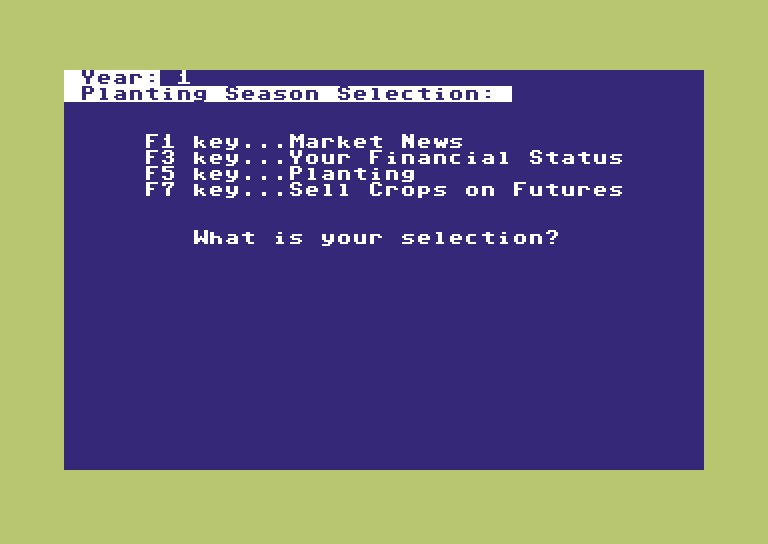
Each year, you're taken to this menu, which gives you four options. (The reason only the odd function keys are used is that the Commodore 64 only has four physical function keys; F2, F4, F6, and F8 are shifted versions of F1, F3, F5, and F7.)
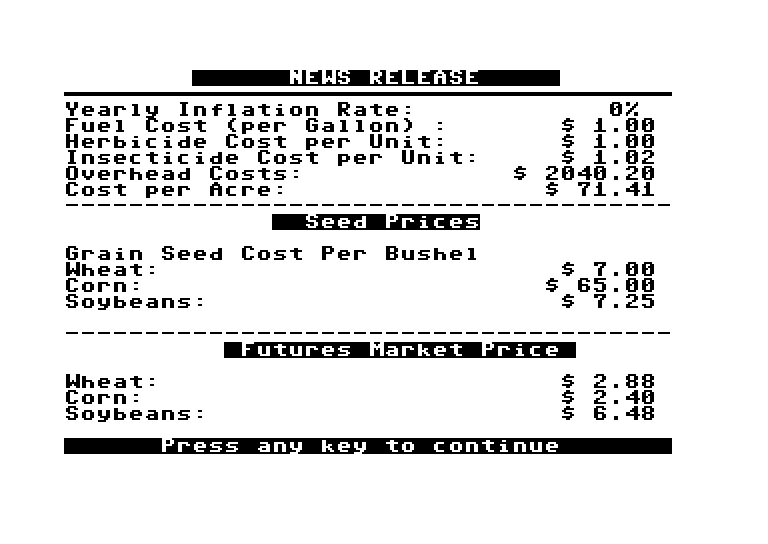
F1 gives you this news release, which is full of useful numbers. It might be a good idea to write them down if you're playing seriously. I wasn't playing seriously.[/foreshadowing]
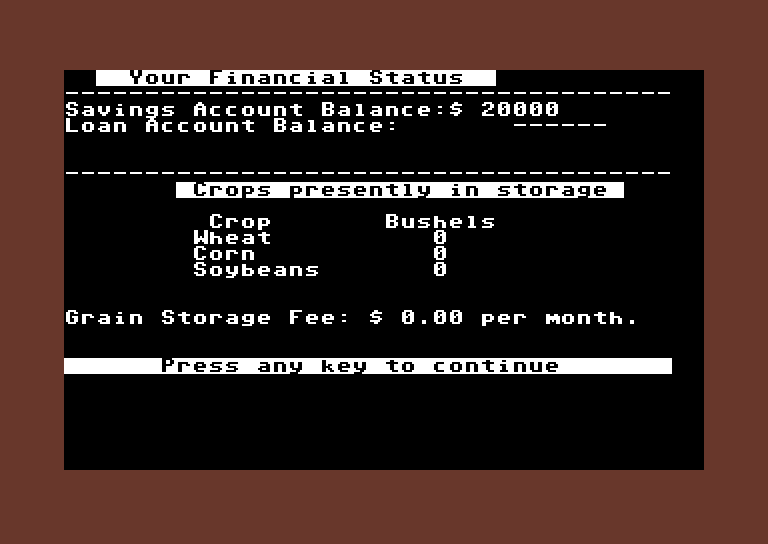
F3 gives you your financial status, as well as your bushels of currently stored grain. (Note: I changed the capitalization of 'Crops Presently in Storage' after I took this screenshot to be more consistent with the rest of the program. It's one of a number of minor presentation changes I made. I kind of want to make some other changes too, but I don't want to get sucked down that rabbit hole.)
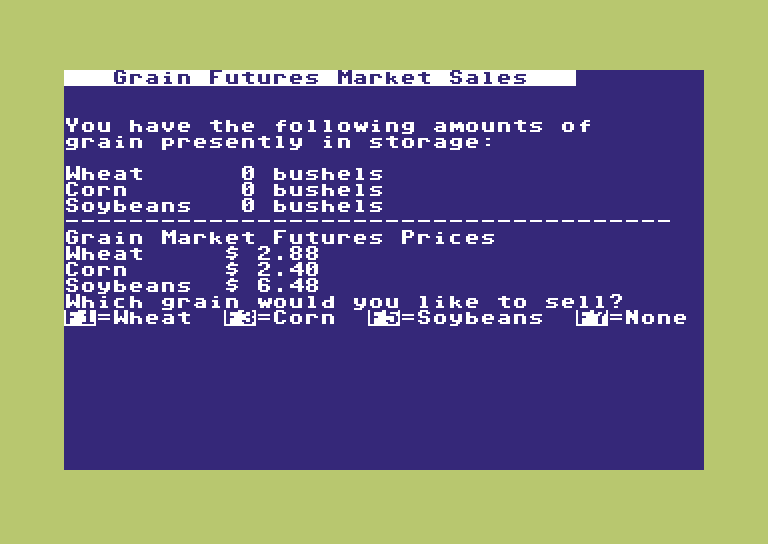
F7 is the futures market. For those unfamiliar with the concept, the futures market is your way of betting on what the price of crops is going to do. When someone wants grain next year, but thinks the price of grain is going to go up, they offer to lock in a price that's more than the going market rate, but less than they expect it to rise to. When you sell grain on the futures market, you're taking that bet, getting more for the grain than you could sell it for right now; the risk, of course, is that you might have gotten much more for it if you'd just held onto the grain until the end of the year.
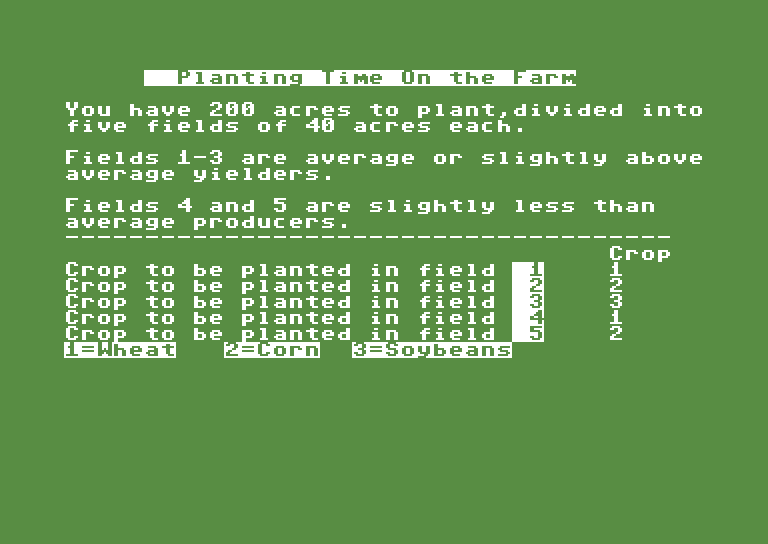
Finally, F5 is the planting menu. (Note that you can't go back to the main menu after entering the planting menu, so get whatever information you need first!) As you can see from the screenshot, you choose which of three crops to plant in each of your five 40-acre plots...
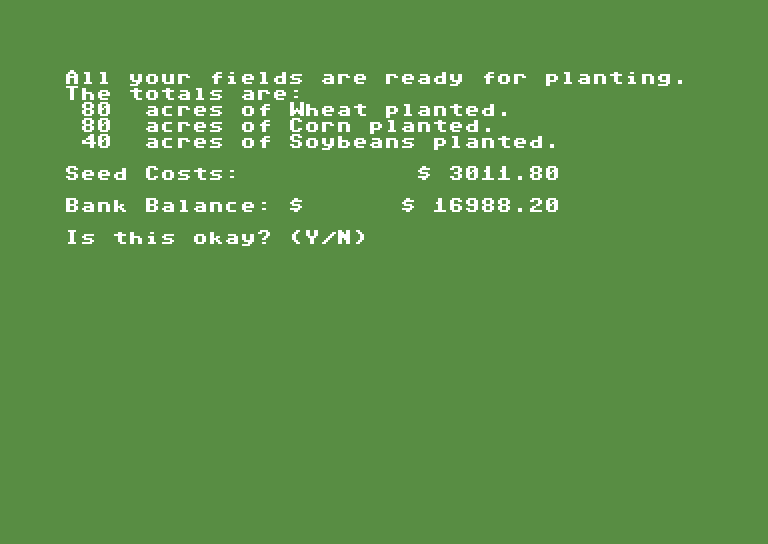
...and you're given a chance to see what that will cost and confirm your decision. (It takes 60 bushels of wheat or soybean seeds to plant 40 acres; corn only takes about 13 1/3 bushels per 40 acres.) You're then asked how many units per acre of insecticide and herbicide you want to apply. The article accompanying the game says the best amount is somewhere between 15 and 35 units per acre. For this turn, I applied 25 units of each.
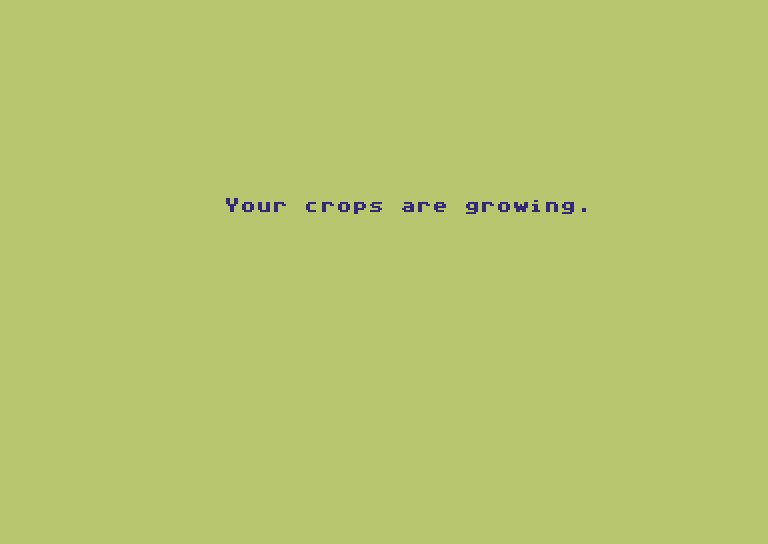
Provided you still have a positive bank balance (I'll get to what happens
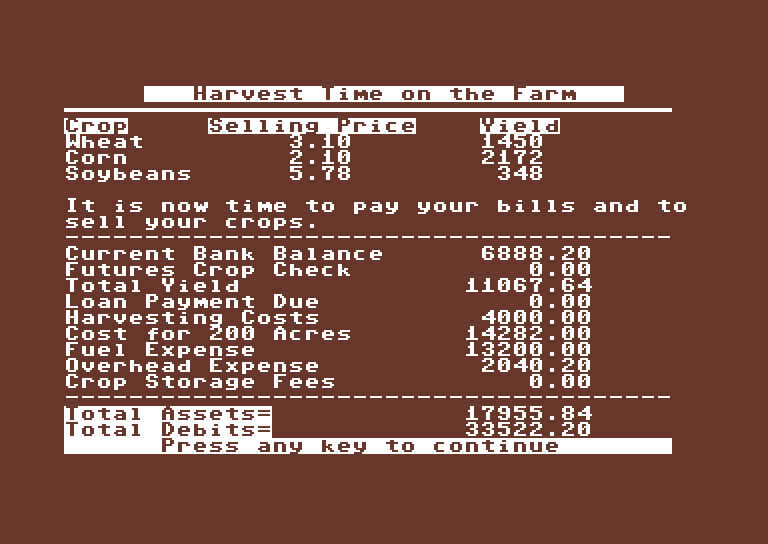
...and move onto this significantly less lovely screen that tallies up the damages. Note that it assumes you will sell all of your crops immediately. As you can see from the last two numbers, I'm in a spot of trouble.
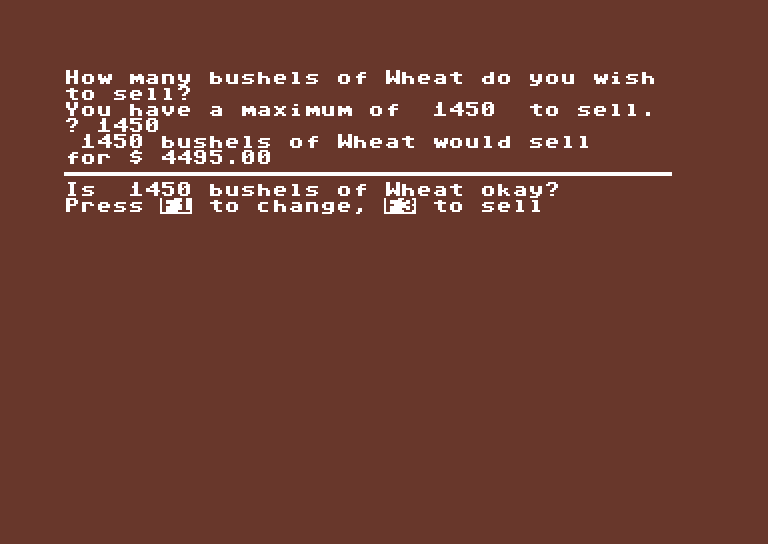
Trouble which I compound by choosing not to sell my soybeans, hoping for a better price later.
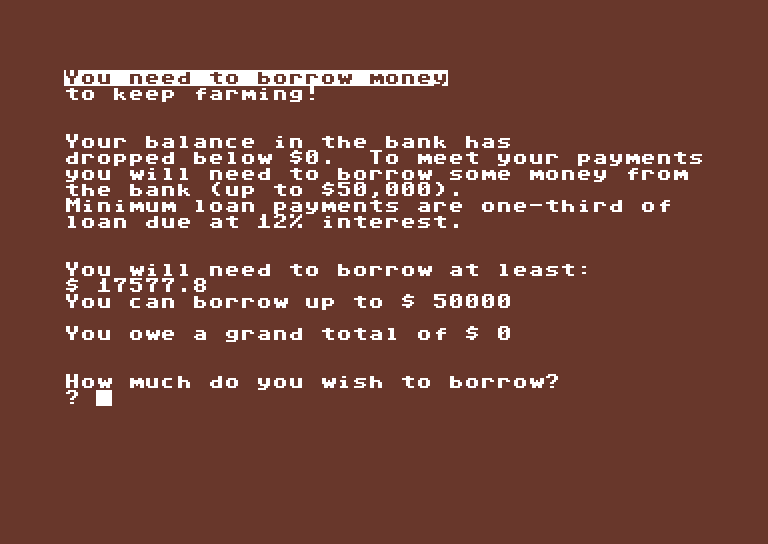
You wind up at this not-so-lovely screen if you're out of money either after planting or after harvesting. (Thankfully, you can sell your harvest first. In real life, I'm pretty sure you have to pay for the harvest before you can sell it.) As the game says, you can borrow any amount from the minimum required to get out of debt up to your maximum line of credit. I have no idea why you'd borrow more than absolutely necessary, though, given that you can take out a loan at any time you need to.
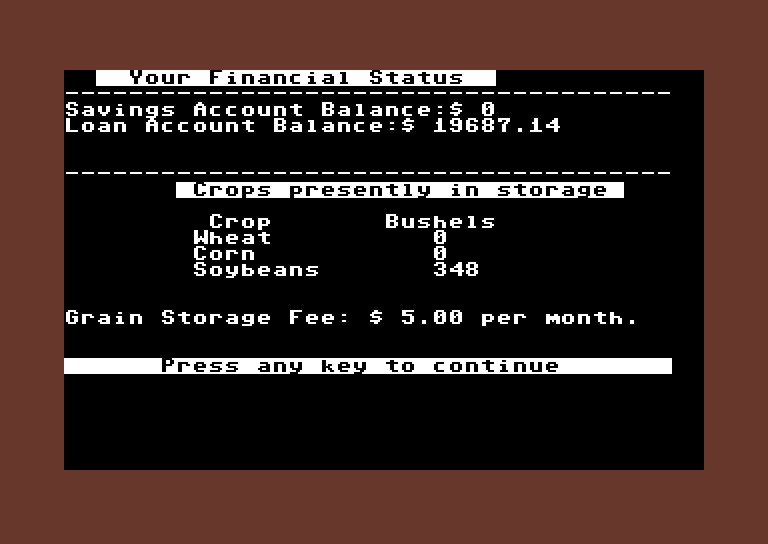
As you can see, my finances are significantly less rosy at this point. I wind up selling my soybeans on the futures market, hoping $6.33 a bushel is a good rate. I also plant the same mix of crops I planted last year (taking out a bigger loan to pay for the seed) and decide to skip insecticide and herbicide. I mean, how bad can it be?
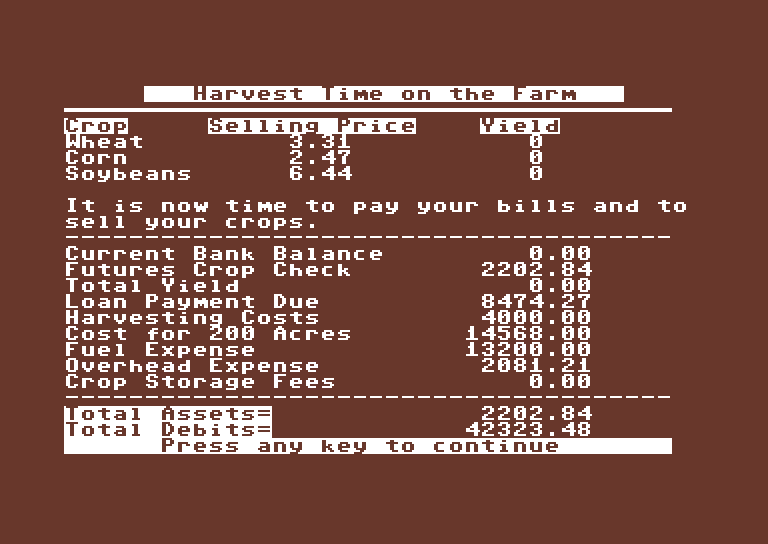
Ah. That bad. (As insult to injury, the price of soybeans went up.)
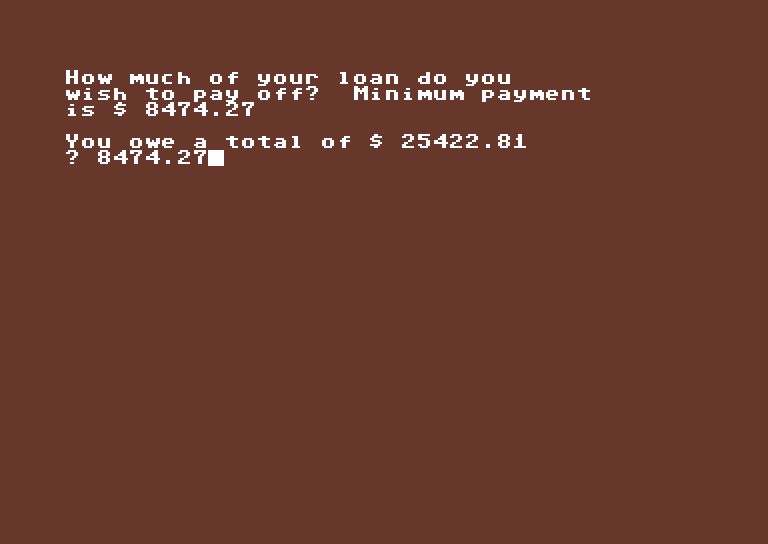
I have to make a payment on the loan, with money I don't have...
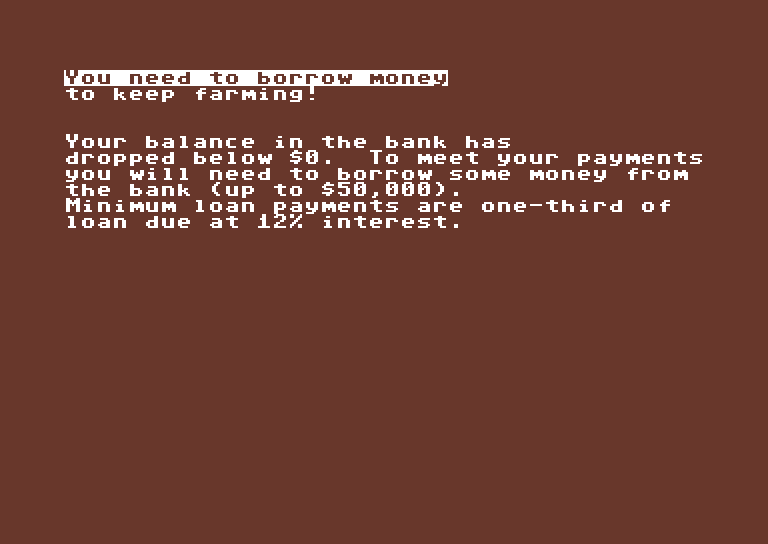
...which means I have to take out a bigger loan.
Uh, there's one problem, though. I can't take out a loan big enough. Which means that, after staring at this screen for a moment...
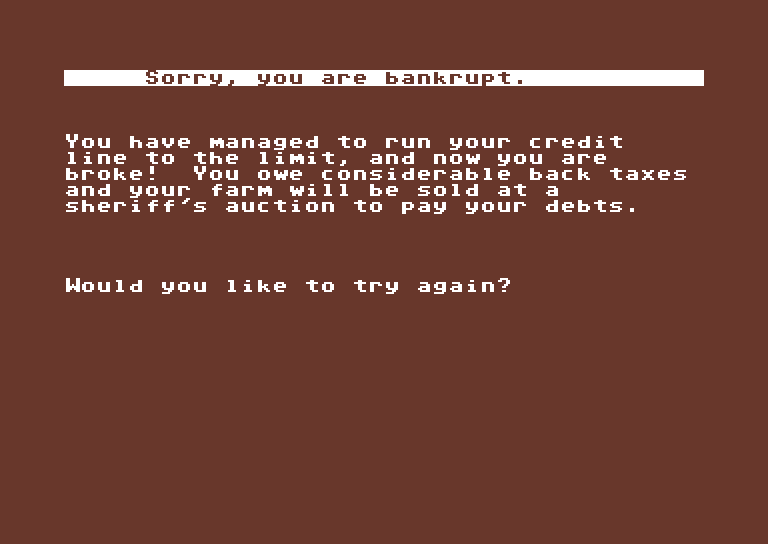
...I get sent to this one. No, The Farm Game, I would not like to try again.
But maybe you would! Download the title image above, rename it to a ZIP file, and extract it to get the .prg and .txt files. If you're actually able to make a farm function for even five years, let us know in the thread; if we get even a few people who manage it, and if there's interest, I'd be happy to host a farm-off.
Or not. There's no shame in being beaten by The Farm Game.
The good: The program is very professionally presented and resistant to players' efforts to screw with it by entering -q.2 as a quantity or getting a negative loan to make that fat interest rate work for them. The code is pretty clean, and while the formulae for the harvest results are an arcane mess, they're not an obfuscated arcane mess, so if you really wanted to you could take the program apart and figure out exactly how it works.
The bad: Dear god the difficulty. There's no option to leave a field fallow until you build up a bit of bank by selling crops, and the information you'd need to decide on your planting regime isn't available from the screen where you have to select it. The bills you incur are huge, and the 12% interest rate the bank charges is nearly usurious. (Google tells me farm loan interest rates these days are closer to 4% at worst.) Even surviving a few years is hard, and to truly win the game, you have to have more money at the end than you started with! All in all, if you want Harvest Moon, look elsewhere. (Hm. Harvest Moon C64. Now there's an idea.)
Also, there are no graphics (the solid horizontal line you see in some of the screenshots is the only time even PETSCII graphics are used) and no sound. No animated scenes of corn stalks swaying in the breeze (or being stripped bare by locusts). No random events to help (or, more likely, hinder), which is the missing feature from Hamurabi I mentioned. And, despite some cute doodles at the start of the article -

- there are no animals to raise.
Ads and articles:
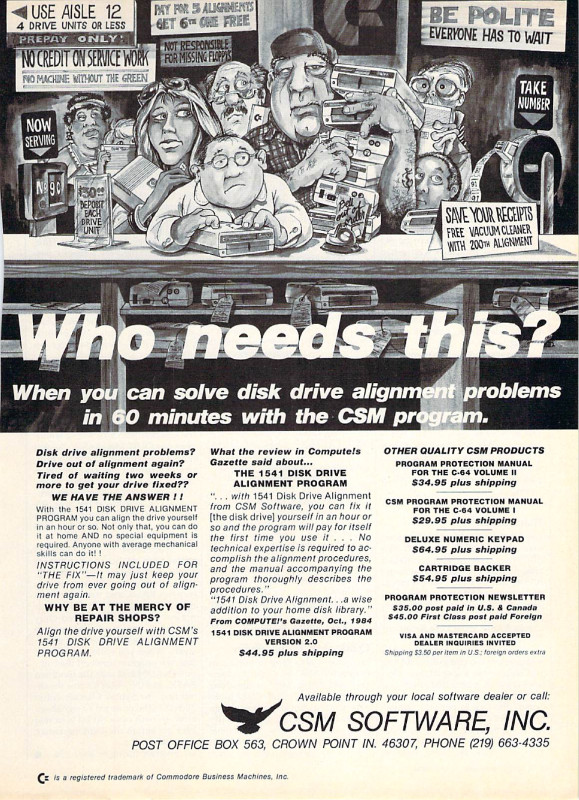
The 1541 disk drive had a design flaw. If it couldn't find the track it wanted to read from on the disk (for instance, the disk hadn't been formatted yet), it would attempt to find the track by moving the drive head a half-step at a time in one direction. Of course, if the disk didn't have any tracks, it'd wind up smacking against a stopper - making a godawful racket in the process - before, eventually, giving up. For bonus fun, every time you formatted a disk, it'd whack the drive head against the stopper to make sure it was in the right place to start making tracks.
Ironically, all this whacking would often put the head out of alignment. This ad touts a software solution for fixing it, which, if I had to guess, would involve alternating digging into the 1541's low-level processes (it had its own computer in there, and you could program it to do some very silly things) and, well, whacking the drive head against its stopper until it was back in alignment.
Mind you, I'm only sharing this ad for the weird art.
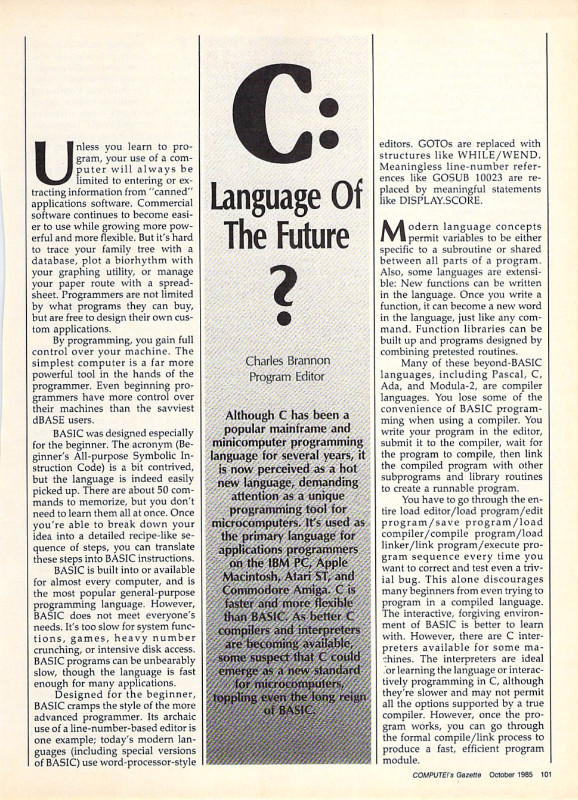
Gee, I wonder.
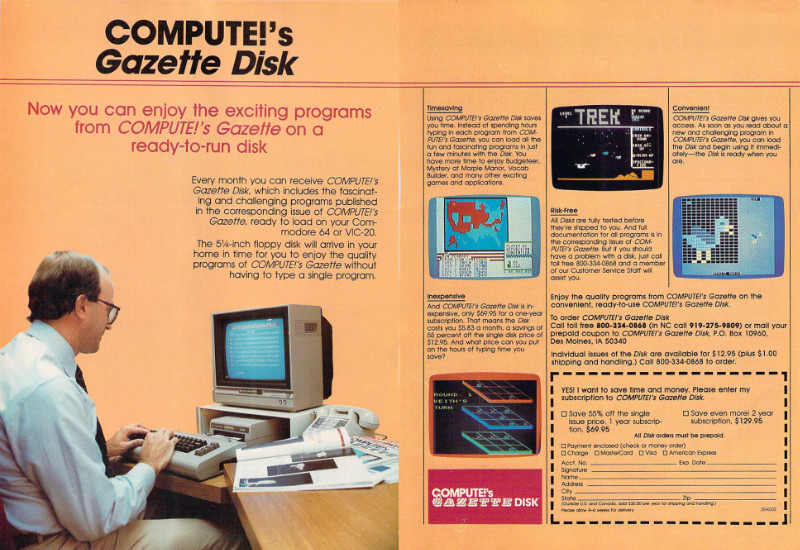
$69.95/year is about $5.83/month. $5.83 in 1985 dollars is about $12.85 in 2016 dollars. This may or may not be relevant later.
